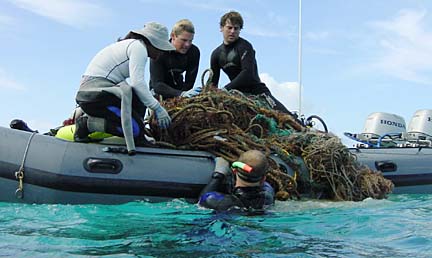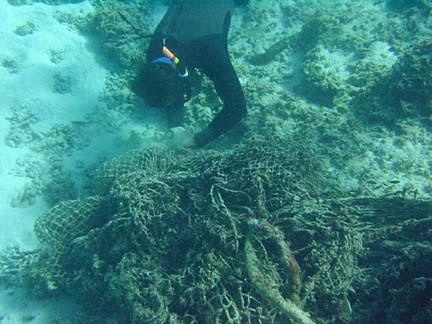


Tons of debris cleared The Townsend Cromwell research vessel returned to Honolulu yesterday with 19,400 pounds of derelict fishing gear gathered during a month in the Northwest Hawaiian Islands.
from NW islands
Some 19,400 pounds of fishing gear
were gathered in 1 monthBy Diana Leone
dleone@starbulletin.comFor every piece of thrown-away fishing net pulled off the coral reefs, the chances of survival for the rare and endangered birds, turtles and monk seals that inhabit the remote islands increases, said Rusty Brainard, National Marine Fisheries Service oceanographer.
Brainard was among the scientists on the vessel earlier this month and said they "couldn't go five minutes without finding a large net" snagged on the coral in some areas.
Since 1996, a growing coalition of state and federal agencies, private organizations and businesses have pooled efforts to get the harmful debris out of the region that many laud as a unique resource.
Brainard said a net doesn't just hook on one location, but "grabs and rips the reef multiple times as it travels in the waves," doing damage every time.
That's why the work to remove the debris is so important.

In 1996 and 1997 combined, 9,610 pounds were removed. In 1999 and 2000, about 50,000 pounds were removed each year.This year's fall cleanup effort has more than doubled over last year, aided by $3 million from the National Oceanic and Atmospheric Administration, parent agency for the fisheries service.
That funding provided for three charter vessels and divers, which spent three months at sea collecting debris and are now on their way to Honolulu, said Hawaii Sea Grant extension agent Chris Woolaway.
"The Townsend Cromwell offloaded nets at Snug Harbor, and Horizon Waste System picked up the bins that had been on the ship," Woolaway said. "This will be baled, then delivered to the plastics recycler, who plans to send it to China."
Woolaway, who was instrumental in getting agencies to work together on the project, said she takes satisfaction in seeing the nets recycled for the first time this year.
Hawaii Sea Grant, U.S. Fish and Wildlife Service, the Ocean Conservancy and other state and private organizations participated in the effort. The U.S. Coast Guard has participated in past years but had to bow out this year in the aftermath of Sept. 11 terror attacks.
Scientists estimate there are still more than 100 tons of derelict fishing gear destroying fragile coral reefs or threatening wildlife.
Mary Donohue, a fisheries service scientist, said even fish being caught in the nets sets up a vicious cycle.
"As the fish get entangled in the net, they become good sources of food for other creatures and the net becomes attractive to other predatory fish and sharks, and consequently, these nets can go on for many years entangling and killing large numbers of creatures."